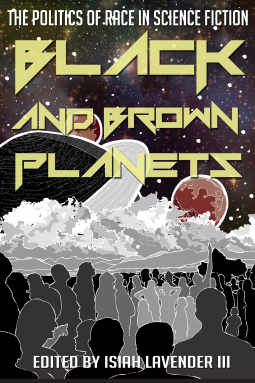
Black and Brown Planets
The Politics of Race in Science Fiction
by Edited by Isiah Lavender, III
This title was previously available on NetGalley and is now archived.
Send NetGalley books directly to your Kindle or Kindle app
1
To read on a Kindle or Kindle app, please add kindle@netgalley.com as an approved email address to receive files in your Amazon account. Click here for step-by-step instructions.
2
Also find your Kindle email address within your Amazon account, and enter it here.
Pub Date Oct 07 2014 | Archive Date Mar 03 2015
Description
Literary explorations into the radical, hopeful racial futures imagined by science fiction
Essays by Marleen S. Barr, Gerry Canavan, Grace L. Dillon, M. Elizabeth Ginway, Matthew Goodwin, Edward James, De Witt Douglas Kilgore, Malisa Kurtz, Robin Anne Reid, Lysa M. Rivera, Patrick B. Sharp, and Lisa Yaszek
Black and Brown Planets embarks on a timely exploration of the American obsession with color in its look at the sometimes contrary intersections of politics and race in science fiction. The contributors, including De Witt D. Kilgore, Edward James, Lisa Yaszek, and Marleen S. Barr, among others, explore science fiction worlds of possibility (literature, television, and film), lifting blacks, Latin Americans, and indigenous peoples out from the background of this historically white genre.
This collection considers the role of race and ethnicity in our visions of the future. The first section emphasizes the political elements of black identity portrayed in science fiction from black America to the vast reaches of interstellar space framed by racial history. In the next section, analysis of indigenous science fiction addresses the effects of colonization, helps discard the emotional and psychological baggage carried from its impact, and recovers ancestral traditions in order to adapt in a post-Native-apocalyptic world. Likewise, this section explores the affinity between science fiction and subjectivity in Latin American cultures from the role of science and industrialization to the effects of being in and moving between two cultures. By infusing more color in this otherwise monochrome genre, Black and Brown Planets imagines alternate racial galaxies with viable political futures in which people of color determine human destiny.
Isiah Lavender III, Baton Rouge, Louisiana, is an assistant professor of English at Louisiana State University. He is the author of Race in American Science Fiction.
Advance Praise
“Isiah Lavender has assembled some of the field’s top scholars and most important emerging voices in an essential volume that shows the range and depth of science fiction’s engagement with questions of race and racism. This groundbreaking collection combines work on well-known writers of colour such as Samuel R. Delany and Octavia Butler with analysis of work by Indigenous and Latino writers such as Leslie Marmon Silko and Ernest Hogan. Reading this collection leaves no doubt that racial difference structures the science fictional imagination, and Lavender’s volume demonstrates both the dangers of complicity with imperialist ideology to which sf can succumb and the power of its tools in the hands of writers of colour to resist and revise racist stereotypes and articulate a more promising future. Joining publications such as Grace Dillon’s Walking the Clouds, Ytasha Womack’s Afrofuturism: The World of Black Sci-Fi and Fantasy Culture, and Eric Smith’s Globalization, Utopia and Postcolonial Science Fiction, Black and Brown Planets promises to be an indispensible reference for understanding the critical ethnic imaginaries of twenty-first century science fiction.”
–Sherryl Vint, Professor of Science Fiction Media Studies, Co-Director of the Science Fiction and Technoculture Studies Program, University of California, Riverside
“Since Mary Shelley and Edgar Allan Poe, science fiction has been troubled by color, with hopeful monsters and terrifying insurgencies intermittently rupturing the genre's pallid certainties. Drawing together African-American SF and indigenous futurism, Black and Brown Planets suggests that now at last their time is here.”
–Mark Bould, Reader in Film and Literature at The University of the West of England and co-editor of Science Fiction Film and Television.
“From Isiah Lavender’s powerful Introduction in which he recounts his first memories of racial otherness and of being the target of racism to Robin Anne Reid’s pioneering Coda in which she brings to SF fan studies the analytical tools of computational linguistics in the service of constructing a social ontology of race, with a dozen fine essays in between, Black and Brown Planets: The Politics of Race in Science Fiction significantly expands and intensifies our understanding of the ways in which “the literature of the future” has sometimes earnestly grappled with, sometimes simply erased, and sometimes blithely ignored issues of race. The essays in this collection, whether from distinguished senior scholars such as Edward James and Marleen S. Barr, from a newer generation of critical expertise represented by Lisa Yaszek, De Witt Douglas Kilgore, Patrick B. Sharp, and Gerry Canavan, or newer still voices such as those of Grace L. Dillon, M. Elizabeth Ginway, Lysa M. Rivera, Matthew Goodwin, and Malissa Kurtz, extend the color line studied in Lavender’s Race in American Science Fiction to global color lines, including those involving indigenous peoples, in America, Brazil, Mexico, and Thailand, always with an eye toward ways in which race and ethnicity figure in the construction of SF societies.”
–Brooks Landon, Herman J. and Eileen S. Schmidt Professor at the University of Iowa
Marketing Plan
No Marketing Info Available
No Marketing Info Available
Available Editions
| EDITION | Hardcover |
| ISBN | 9781628461237 |
| PRICE | $60.00 (USD) |
Average rating from 16 members
Featured Reviews
 Leslie G, Book Trade Professional
Leslie G, Book Trade Professional
this book is a readable voyage of discovery for some one like me - i enjoyed Mosley's new one, and his eariler Futureland, observing he used it somewhat as a place to discuss difference - I only now learn that also Samuel Delaney was a writer with black heritage - this shifts for me sci fi into an even more sophisticated realm that i'd thought - and this volume goes through the whole scope of issues - not only racism but also what future is about in counter-acting imperialist worlds - wars of worlds and implications are thematised - issues of immigration, sexism and racism are picked up in equable ways in this admirable work - i hope many people read it - its tone is mild and engaging, not doctrinaire when it might have been - highly recommended
 Daniel H, Reviewer
Daniel H, Reviewer
In his introduction to this collection of essays, Isiah Lavender III explains that Black and Brown Planets continues a conversation started in the science fiction community with Elisabeth Leonard’s 1997 anthology, Into Darkness Peering: Race and Color in the Fantastic. The cultural and literary criticism found here in looking at works of the recent past become particularly significant as we comprehend a future where, as Lavender III puts it, “the Western world ceases to be dominated by the white majority”:
"SF has charted a few of the alternatives for this unknown territory, and the change presents both opportunities and challenges for society to establish new values. In short, skin color matters in our visions of the future…[To] transcend various repetitions of the color line – black, red, and brown – we must be conscious of these repetitions."
As subtitled, Black and Brown Planets focuses on the politics (the strategy of obtaining a position of power/control) of race in science fiction with the essays divided into two parts. As with any criticism, it can be most fully appreciated if you are intimately familiar with the material being discussed. Yet, while helpful, I wouldn’t consider it essential for several of the essays here; they still have relevance that can be conveyed to interested readers.
Part One focuses on the portrayal of Black identity in science fiction from the African-American to Afrofuturism to postcolonial analysis in general. Living in the United States, having traveled to Africa, and having studied some French postcolonial literature, I personally found this part of the collection to be more approachable and comprehensible due to familiarity.
In this Black Planets part, essays by De Witt Douglas Kilgore and Gerry Canavan consider the simple but profound “Far Beyond the Stars” episode of Star Trek: Deep Space Nine, which addresses racism and gender bias in the history of science fiction publication. Simultaneously, as Kilgore points out, the episode marks a contrast of the past to a present-day vision of the future where a Black man is a Starfleet captain, station commander, and a political and spiritual emissary to another race: an Afrocentric politic where “people of color determine human destiny” (as put by Lavender in his intro).
Though I’ve seen “Far Beyond the Stars”, I haven’t read The Star Pit, the other focal point of Canavan’s essay. Similarly, I haven’t read The Evening and the Morning and the Night discussed in Lavender’s contribution. However, I have at least read enough works by Samuel R. Delany and Octavia Butler to be familiar with their style and themes, permitting me to appreciate the general critiques. In a way, extending Susan Sontag’s Illness as Metaphor criticism, Lavender’s essay considers Butler’s story of disease as metaphor for race where “those suffering from [a] fictional genetic illness…are in fact victims of cultural racism.” I look forward to reading these stories and returning to their discussion in these essays anew.
The final essay in the Black Planets portion of the book by Marleen S. Barr is noteworthy for offering appreciation for the power and potential the science fiction genre has had — and can achieve — to promote positive change from a young age. Yet, it also servers equally as a warning of how perpetuation of racial dominance or the ‘erasure’/’disregard’ of the Other’s presence in the genre can be dangerously manifested.
Brown Planets makes up the second part of the collection and includes consideration of Hispanic, Amerindian (indigenous), and, briefly, Oriental identity in science fiction. The specific discussions of these essays were admittedly harder for me to grasp, but their overall themes of addressing the effects of colonization and postcolonial recovery (return to the traditional) should be clear to all. Likewise, the connection of this process to the apocalyptic genre is intriguing.
The second portion also contains interesting reflections on the science fiction themes of technological and/or corporate dominance and how these are used in plots and settings to alienate and repress. This analysis for me was clearest in Malisa Kurtz’ essay — again because of my familiarity with the subject, in this case her focus on the works of Paolo Bacigalupi. Bacigalupi’s works are intentionally disquieting in terms of technology, class, and environment. But for some reason, I had not recognized their equal critique of racial inequity that continues to be violently perpetuated in the bleak futures that many of his stories serve to paint.
Lavender concludes Black and Brown Planets with a “coda”, an essay by Robin Anne Reid that is one part criticism and one part data compilation/statistical analysis. Subtitled “The Politics of Race in Science Fiction Fandom”, it begins equally with the politics of gender.
Reid reviews the formation of the Carl Brandon Society at “the oldest and only feminist science fiction convention”, WisCon, in 1999. Forming in response to Delany’s 1998 article, “Racism and Science Fiction,” in The New York Review of Science Fiction, the group took its name from a 1950s fictional black fan invented by Terry Carr and Peter Graham. Its mission is “to increase racial and ethnic diversity in the production of and audience for speculative fiction,” and its vision is “a world in which speculative fiction, about complex and diverse cultures from writers of all backgrounds, is used to understand the present and model possible futures; and where people of color are full citizens in the community of imagination and progress.”
She then proceeds to relate the online fan ‘call-out’ dubbed The Wild Unicorn Check-In, where fans of color responded to a generalization by Lois McMaster Bujold by ‘calling out’ the white science fiction community for remaining ignorant of their existence (both present and past) in this “community of imagination and progress.” Bujold’s comment was viewed as a form of erasure, similar to one that can occur in alternate-history forms of science fiction where exploitations or non-dominant cultures are glossed over or excised.
After the historical background is established, Reid sets out to present an ontological study of this fan ‘call-out’ through a series of tables that illustrate the diversity of terms that were used by fans as self-identification: racial, ethnic, national, etc.
I found Reid’s essay particularly relevant in light of another fictional fan (in this case an invented reviewer persona that served as social critique/performance art) and the questionable behaviors in reaction to her recent identification online. This incidence reinforces the points of Reid’s critique and The Wild Unicorn Chick-In itself. Namely, that “erasure of entire cultures based on racism exists, as do erasures of women and queer people” and that both the politics of race and gender continue to rear their ugly heads as individuals either willingly or unwillingly act/react to maintain dominance and control, perceived or actual.
The coda thereby serves as a fitting close to the collection, illustrating that the concerns of Black and Brown Planets extends beyond the physical pages of science fiction publications to the social interactions of the community itself, even online. Though it is the end to Lavender’s collection, he speaks in the introductory acknowledgements of additional essays that he couldn’t include, presumably due to length and publication costs. I recommend checking these essays out and will hope that this collection’s success will permit a follow-up, including discussion of African literature which is beyond the scope of this collection.










